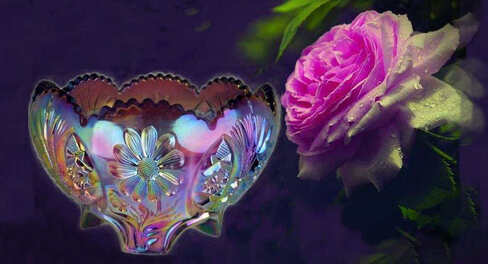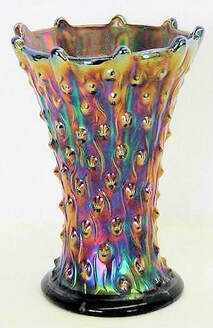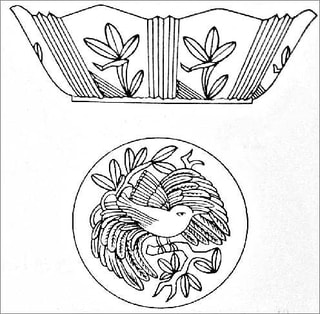NetworK ezine Issue 69. February 2021
Totally Devoted to Carnival Glass
Happy Valentine’s Day
|
An early Valentine's Day wish, courtesy of Eda Glasbruk Amerika (aka Sunk Daisy) rose bowl in purple. In this issue ... we take a look at some amazing discoveries from around the world. We all love to hear about new and exciting finds, and these are all significant items – ground-breaking in their own ways. So, hold on for a worldwide, whirlwind tour of discovery!
The first discovery we feature in this issue is this fascinating ad, shown courtesy and thanks to Joan Doty. Patent medicines claiming to cure all manner of ailments were common around the time that Classic Carnival Glass made its debut in the early 1900s. But who could possibly have imagined that a free gift of a Carnival vase could have been offered as an incentive to purchase an herbal (medical) cure? |
This amazing old ad, below left, for King’s Bed Wetting tablets (intended to stop the problem, not enable it) was in an old home products catalogue from the King Manufacturing Company of St. Louis, Missouri. It was discovered by the late Don Moore. We are very grateful to Joan Doty for spotting it for us and allowing us to feature it in NetworK.
The text in the ad, describing the vase, is delightful. It reads: “Iridescent Glass Flower Vase Free. This is a novel and beautiful kind of glassware made by a new process, and shows all the beautiful colors of the rainbow. It stands about 7 inches high.”
|
The ad is not dated, but note that it refers to “a new process” which suggests that iridescent (Carnival) was in its early days. Northwood’s Tree Trunk vase had been made in opalescent glass from around 1907, prior to Carnival being made. Butler Brothers ads show an iridescent version alongside other Northwood Carnival items such as Strawberry and also Grape & Cable, in 1910. It seems likely that the King’s ad for the free Tree Trunk vase was around that date too. |
Above: a Purple Tree Trunk vase courtesy Seeck Auctions.
|
|
King Manufacturing Co. was well known for its restorative sarsaparilla.
Typical of the era, exaggerated claims were made for all manner of pills and potions, and the “blood purifier” sarsaparilla was no exception, as Mr D Draper’s testimonial in this 1892 ad (right) explained. Other companies marketing similar items also offered glassware as incentives to buy their products, as seen in the amazing Zanol ads in which Imperial’s Four Seventy-Four items were given away free. These brilliant ads are shown here: Zanol. The Lee Manufacturing Company (well known for its baking powder) also sold a wide range of potions and cosmetics. Carnival Glass was also one of their popular premiums, as the ads here show.
Above: the offered “Iridescent Art Mug” was of course Northwood’s beautiful Singing Birds – it was free when the customer bought Lee Manufacturing's Tooth Soap. The 1911 ad. is courtesy Lance Hilkene.
On the right is a Northwood Singing Birds mug in marigold. Courtesy Seeck Auctions. |
|
Above: just 15 cents for Lee’s Witch Hazel and Carbolic Salve. Or perhaps you prefer an Orange Tree mug instead for the same price. Both ads from our copy of a 1915 Lee Manufacturing Catalogue.
|
Fenton made Orange Tree mugs in two sizes.
A so-called "shaving mug" which is wider base (shown above on the left in blue), and the regular size (on the right in marigold). Picture courtesy Seeck Auctions. |
|
Fenton Panel Vase Discovery
This fascinating, purple vase (right) was discovered by Christine Batch in Australia, and was recently posted in our Carnival Glass NetworK Facebook Group. Photos are courtesy of Christine Batch. Christine told us that the vase stood 13.2 inches tall (34 cm) and had a smooth 4-inch (10 cm) diameter base. The vase has nine panels. We felt that it was possibly a Fenton Panel vase, but the top shaping seemed very unusual. Our experience with Fenton Panel vases is very limited, so we turned to vase expert, Joan Doty, for help with this discovery, and she confirmed that the vase was indeed Fenton Panel.
|
Christine Batch's vase sent to our
Carnival Glass NetworK Group on Facebook. Left: two Fenton Panel midsize vases with one standard size. Courtesy and Copyright, Joan Doty.
|
|
Discovery in Finland - Lyyra
Researcher and writer, Roger Peltonen, shows us this amazing marigold Lyyra bowl from Riihimaki. To the best of our knowledge this is the first report of this beautiful item in Carnival. Roger tells us about this distinctive and unusual item:
“Riihimäki's popular Art Nouveau pattern ‘Lyyra’ appears in the catalog from 1915 on drinking glasses, bowls, plates as well as sugar bowls and creamers. The plates are modified from bowls (so there have been only two moulds in use) and they all are missing from the catalog from 1939. The larger bowl in marigold is thus quite unusual.” This is a beautiful and unusual piece of Carnival – an amazing discovery. Our grateful thanks to Roger for sharing it with us all. |
Above and left: Lyyra bowl by Riihimaki.
Photos courtesy of Roger Peltonen. Above: extracts from 1915 Riihimaki catalogue.
|
Discoveries in Poland
Not just one, but two amazing discoveries in Poland have been reported to us by Wojtek Wrzyszczyński. Wojtek is a writer and researcher on glass, with a special interest in Polish Carnival. He has kindly allowed us to share his photos of these two amazing discoveries with our readers around the world.
Ring-Around in blue
Not just one, but two amazing discoveries in Poland have been reported to us by Wojtek Wrzyszczyński. Wojtek is a writer and researcher on glass, with a special interest in Polish Carnival. He has kindly allowed us to share his photos of these two amazing discoveries with our readers around the world.
Ring-Around in blue
|
Ring-Around ashtray in blue glass with iridised floral design, from Zabkowice. Courtesy and Copyright Wojtek Wrzyszczyński.
(Note: the ashtray is a very large piece of glass). |
The intaglio design on the underside of the base of this blue ashtray appears to be a slightly larger version of a pattern named Circled Rose (shown below) - which is iridised in the same way as other Zabkowice's "Golden Patterns". They are all on our website in our Golden Treasures article (the link is at the end of this section). In fact, Zabkowice made a wide range of designs in this style where the pattern is intaglio on the underside of the base, and selectively iridised in marigold. Many of them are in this major feature: Zabkowice's Golden Treasures.
|
|
The ashtray shown above is the first example of blue glass with iridescence that we have seen on Polish glass. The pattern named Ring-Around is the design of interlinked / overlapping circles around the outside of the piece. Here on the right is another Zabkowice Ring-Around ashtray. This one is a deep marigold around the sides. The base is clear, with a different (non-iridised) intaglio pattern - a version of their “Snowflake” design. We have a special feature article showing four pages of stunning "Golden Patterns". Some will amaze you, some will surprise you: fish, fruit, flowers, swans, a bulldog, a cherub ... and more. They are all here: Zabkowice's Golden Treasures Right: a Ring-Around ashtray, with an
extract from the 1939 CHC catalogue. |
|
Bluebird
The second discovery by Wojtek in Poland is this exquisitely lovely Hortensja bowl that Wojtek has named “Bluebird”. The sides of the bowl are brilliantly iridised in shimmering pastel marigold, while the base is clear and has a wonderful "frosted" intaglio design of a bird. |
Above: extract from Hortensja catalogue showing the Bluebird design.
Left: Bluebird bowl by Hortensja. Courtesy and Copyright Wojtek Wrzyszczyński. |
Wojtek has a Facebook Blog about glass, which can be seen here: Blog
A Discovery in Brazil
Now we turn to the southern hemisphere for yet another fascinating new discovery from Claudio Deveikis. Claudio described it perfectly to us as a “heavy plate – 1.2 kg or 2.6 pounds” – and you can tell by his photos that this is also a weighty piece.
Claudio also tells us that the plate is 26.5 cm (1.-5 inches) in diameter. Although it is not marked with the name of the maker – Esberard – Claudio found the exact item in the Esberard catalogue, as well as a stemmed centerpiece comport in the identical pattern.
Now we turn to the southern hemisphere for yet another fascinating new discovery from Claudio Deveikis. Claudio described it perfectly to us as a “heavy plate – 1.2 kg or 2.6 pounds” – and you can tell by his photos that this is also a weighty piece.
Claudio also tells us that the plate is 26.5 cm (1.-5 inches) in diameter. Although it is not marked with the name of the maker – Esberard – Claudio found the exact item in the Esberard catalogue, as well as a stemmed centerpiece comport in the identical pattern.
|
Photos courtesy and copyright Claudio Deveikis.
Our grateful thanks to Claudio for sharing. |
Above, left and centre: the low plate and stemmed centrepiece items in the Esberard catalogue c. 1940s. Right: the same centrepiece as base, plus an epergne lily was shown in an earlier, 1907 Esberard catalogue.
|
Sommers Discovery
And let’s close this issue of Network with two more splendid discoveries – thanks to Joy Stallock Ostlund and Stan Hoegerman. Recently, in our Carnival Glass Network Facebook Group, Joy told us that she had come across a 1910 G. Sommers & Co. catalog (St. Paul, Minnesota). She explained that it was falling apart at the seams, but she managed to capture the images of four amazing block ads for Carnival Glass for us all. These were called fascinating names such as “New Northern Gold” and “Tiffin Iridescent”. The drawings are a delight and the information they reveal is fascinating.
And let’s close this issue of Network with two more splendid discoveries – thanks to Joy Stallock Ostlund and Stan Hoegerman. Recently, in our Carnival Glass Network Facebook Group, Joy told us that she had come across a 1910 G. Sommers & Co. catalog (St. Paul, Minnesota). She explained that it was falling apart at the seams, but she managed to capture the images of four amazing block ads for Carnival Glass for us all. These were called fascinating names such as “New Northern Gold” and “Tiffin Iridescent”. The drawings are a delight and the information they reveal is fascinating.
We have created a special feature here our website for the Sommers catalog pages, as we were honored to already have some other Sommers’ ads courtesy of Stan Hoegerman (we showed one of these in our NetworK 52). Stan’s were from 1926, and it is most interesting to see these two catalogs – some sixteen years apart – on our website. We hope you will enjoy the feature, and we wish to thank, most sincerely, Joy and Stan for sharing and especially for their help and their time.
The 1910 catalog features assortments from Fenton, and the 1926 catalog concentrates on Imperial selections.
To see all the amazing assortments of Carnival Glass that was on offer in these Sommers catalogs, click on the images above, or here:
If you have missed any of the previous issues of NetworK and NetworK Specials, they are all here: Back Issues.
Privacy and the use of your information: we only use your name and email address to send you your FREE Carnival Glass NetworK ezine. We will not share your name or email address with anyone else, or use it for any other purpose. You can change your mind about receiving your NetworK ezine at any time by clicking the unsubscribe link at the foot of every issue, or by emailing us at [email protected]
Join us on Facebook
We would love you to come and join in the fun, and we invite you and your friends to join us all on NetworK's fast growing and very active Facebook Group!
We would love you to come and join in the fun, and we invite you and your friends to join us all on NetworK's fast growing and very active Facebook Group!




























